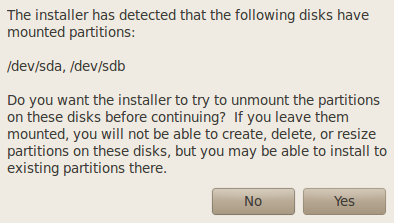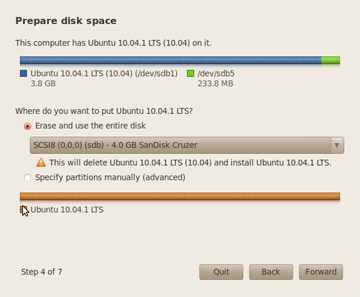How To Guide: 3 Ways to Boot Ubuntu 10.04 from a USB Flash Drive
This guide will explain the steps to install Ubuntu Linux 10.04 Desktop Edition to a flash drive. There are three options to explore: Live USB, Persistent Live USB, and direct install to USB. We will cover the necessary steps to accomplish each type of install.
Option 1: Boot Ubuntu as a Live CD from a USB Flash Drive
Use this option to install Ubuntu as a Live Install, which allows you to boot from the USB flash drive in Ubuntu, experience the Linux environment but will not retain any changes or settings after you shut down. This is a great way to get a feel for the OS, test some of it’s capabilities as well as typical hardware compatibility.
What you will need:
Running Windows XP/Vista/7
Fat32 Formatted USB 2.0 Flash Drive, at least 1GB
PC with a Bios that can boot from USB
Now with all of the necessary components in place, we can begin to setup our Ubuntu Live USB Drive.
1. Run the Universal USB Installer by Pendrivelinux.com that you downloaded earlier.
2. Choose Ubuntu 9.10/10.04.1 Desktop i386
3. Select the Ubuntu Live CD that you downloaded earlier
4. Choose your Flash Drive
5. In this instance, we are going leave the persistence option unchecked.

This can take anywhere from 15 minutes to 30 minutes depending on the speed of your system. At one point the progress bar will freeze until it is done, and this is the lengthiest wait of the process.
Once complete, you can reboot your computer with the USB flash drive in the USB port, press F12 for the Boot Menu and choose the removable media to boot from and you are in.
As this is a Live USB, any changes you make to the Ubuntu environment will not persist through a reboot. This is because running in this mode, Ubuntu uses available RAM in place of Swap and Hard Disk space. This option also contains the install files needed to install Ubuntu directly to your desktop if you should so desire.
Option 2: Boot Ubuntu as a Live CD with Persistence from a USB Flash Drive
This option will install Ubuntu Linux onto your flash drive with an area for persistent storage. You will be able to restart the computer, boot back into the Linux environment and all settings or changes made previously will persist.
NOTE: This option is particularly hard on Flash Memory, as there can be quite a bit of reading and writing to the Flash Memory.
What you will need:
Running Windows XP/Vista/7
Fat32 Formatted USB 2.0 Flash Drive, at least 2GB
PC with a Bios that can boot from USB
Now with all of the necessary components in place, we can begin to setup our Ubuntu Live USB Drive.
1. Run the Universal USB Installer by Pendrivelinux.com that you downloaded earlier.
2. Choose Ubuntu 9.10/10.04.1 Desktop i386
3. Select the Ubuntu Live CD that you downloaded earlier
4. Choose your Flash Drive
5. Select the Persistence Option of 1GB Casper-RW

This can take anywhere from 15 minutes to 30 minutes depending on the speed of your system. At one point the progress bar will freeze until it is done, and this is the lengthiest wait of the process.
Once complete, you can reboot your computer with the USB flash drive in the USB port, press F12 for the Boot Menu and choose the removable media to boot from and you are in.
As this is a Live USB with Persistence, any changes you make to the Ubuntu environment will keep through a reboot. This option also contains the install files needed to install Ubuntu directly to your desktop if you should so desire.
Option 3: Install Ubuntu directly to a USB flash Drive
This option works through installing Ubuntu to the flash drive as a complete installation. It does not retain the installation files to install on another system. This will allow you to use Ubuntu exactly as if it were installed alone on the hard disk. You can boot from it with any computer that can boot from a USB flash drive.
Note: This method requires that you disable your hard drive in BIOS to prevent overwriting your current operating system and force the install onto the USB drive.
What you will need:
USB 2.0 Flash Drive, at least 4GB
PC with a BIOS that can boot from USB
Blank CD
A Computer with the ability to Burn CD/DVD
Now with all of the necessary components in place, we can begin the process.
1. First, you will need to burn your Ubuntu ISO to CD using a program like ImgBurn.
2. Boot your computer and press F2 to enter the system BIOS. Within here you will want to disable your Hard Drive. If this is not an option in your BIOS, I would suggest shutting down your computer and unplugging the power and data cables from your hard drive before proceeding. NOTE: If you choose not to disable your hard drive, you run the risk of installing Ubuntu on top of your current OS and can lose valuable information.
3. After you have disabled your hard drive, place the Ubuntu Live CD into your computer and boot from this.
4. At the initial boot screen, choose to try Ubuntu, not install.
5. Once Ubuntu loads, plug in the desired flash drive into the computer.
6. Now, double click on the Install Ubuntu icon that appears on the desktop.
7. The first 3 screens are language, time zone, and keyboard layout.
8. Now Ubuntu will notify you that there is a disk mounted, and asks to unmount it. This is your flash drive. Give it permission to unmount.

9. This is the prepare disk space screen. I chose to leave mine at default and let the installer handle the partitions needed by Linux.

10. Now you will see the login and user information screen.

11. Now you are ready to install, click install.
12. At one point during the installation, you may notice a skip button appear on the bottom left. This is to skip the auto update, and finally the language packs. I chose to skip language packs update.

13. This may take a while, mine took atbout 35 minutes to complete. When it is done, eject the disk and shut down the computer. Plug your hard drive back in if necessary, or boot your computer into bios and re-enable it. Reboot your computer and press F12 to enter the boot menu, choose the flash drive and boot into Ubuntu.
Thank you for joining us for this How To Guide. Check back often for new posts.
